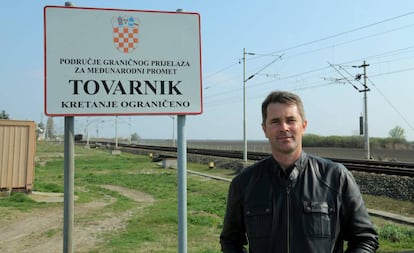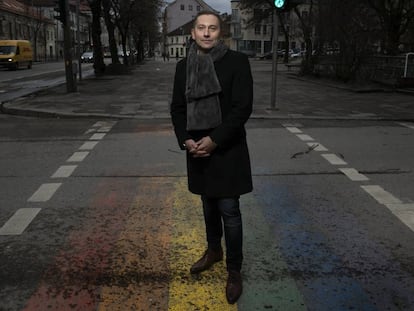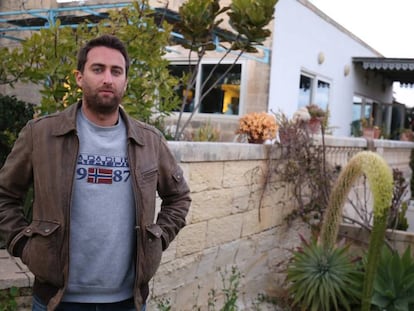Will Croatia climb aboard the Schengen train?
After the refugee crisis of 2015, the country is keen to show it has control of its borders in a bid to be admitted to the EU’s area of free movement


“To say the police were not prepared would be an understatement. Quite simply, I never dreamed so many people could enter in a single night. There was nothing I could do,” says Dubravko Blaskovic, as he recalls the famous refugee crisis in 2015 while standing in the vicinity of two images that became closely associated with it – a welcome sign in Tovarnik, a hitherto insignificant Croatian town on the border with Serbia, and the rail tracks connecting Belgrade to Zagreb, which thousands of people followed like a compass to the heart of Western Europe.
Blaskovic was, and still is, president of the regional council of Vukovar, which includes Tovarnik. Yasmin Budinsky was the deputy mayor of the town. Their desperate pleas four years ago when more than a million people came through here en route to Europe highlighted the unprecedented scale of the refugee and migrant challenge facing the European Union. “In a day and a half, around 5,000 refugees arrived in Tovarnik,” says Budinsky.
At the peak of the crisis, Syrian odontologist Nizar Shoukry, who had come to Croatia to study in 1984, and his Croatian wife were recruited as translators. They were able to converse with Arabic refugees who were exhausted by their flight from the violence and terror back home, and often had no idea where they were.

“What we saw these people going through is hard to put into words,” says Shoukry who now has a clinic in Tovarnik. “We tried to calm them down, but there were times when there was a lot of tension. In the first days of that winter, we tried to protect the women and children. But they were in the middle of a journey that lasted thousands of kilometers and you could feel their desperation. We introduced some calm into the chaos.”
Shoukry and his wife were acknowledged for their efforts. And today, their attitude reflects the tranquility of this small town of one-story houses, which is home to 1,300 residents and where the only sound is that of tractors and the odd car or bicycle bell. “The situation now is far more peaceful,” says Budinsky. “We see sporadic attempts to enter the country but the police have everything under control.”
In 2015, Croatia had been a member of the EU for just two years but it did not belong to the Schengen Area of free movement which covers 22 member states as well as Norway, Iceland, Switzerland and Liechtenstein. Today, it remains outside the Schengen Area which has been largely undermined over the past five years by border controls in a number of European countries, including Germany and France. Indeed, just recently, French President Emmanuel Macron announced: “Schengen doesn’t work anymore.” It seems that what began as an emergency measure in response to the crisis has been accepted as the new reality. “It’s a paradox,” says Marta Zorko, a geopolitical expert from Zagreb University. “Schengen was invented so we would have strong exterior borders while protecting freedom of movement within. But with the migration crisis, there was a fluid exterior border and EU countries were shutting themselves off in small national capsules.”
Along with Bulgaria, Romania and Cyprus, Croatia still aspires to belong to this area of free movement. First, there are technical criteria to be met, which the Croatian government is currently working on; and then the country needs the unanimous support of the EU’s member states.
Croatia is a pawn in the system. And at times a pretty brutal pawn
Sociologist Drago Zuparic Iljic
In short, Croatia’s admission to the Schengen Area largely depends on the political will of the EU. And in an EU dealing with nationalism, migration and terrorism, not to mention Brexit, admitting new members to the Schengen club is not a top priority.
The prospect of joining the club is further complicated by Croatia’s territorial dispute with Slovenia over waters in the northern Adriatic Sea. Also formerly part of Yugoslavia but now a full member of the EU, Slovenia has threatened to veto Croatia’s candidacy.
Dubravka Suica, a Croatian Member of the European Parliament (MEP) from the European People’s Party group and former mayor of Dubrovnik, makes the case that Croatia is different from the other candidates hoping to join the area of free movement. “Bulgaria, Romania and Cyprus have been trying to get in since at least 2011 and they have not managed, despite meeting all the technical criteria,” she says. “That is because they are being blocked by several member states, mainly Germany, the Netherlands and France, which have reservations, generally about whether they are falling short of the political criteria, like flaws in the rule of law and the fight against corruption. The admission of Croatia into the Schengen Area hasn’t been possible until now because of our long and diverse border that makes our situation complex and because of technical criteria, but our candidacy has received a lot of political support.”
Almost 300 kilometers from Tovarnik and some thousands of kilometers from the EU headquarters, the government in Zagreb insists that Croatia is ready. After years of delay, it now has its sights set on the second quarter of 2020.
Croatia has 1,300 kilometers of border with non-EU countries
“It doesn’t just depend on what Croatia is doing,” says Terezija Gras, secretary of state in Croatia’s Interior Ministry. “It also depends on the internal procedures within the European Commission which are not always as fast as we would like. The discussion is not in our hands; we can’t make it happen. Of course, the refugee crisis and the terrorist attacks have altered the mood in the EU, but Croatia is used to joining associations in what we might call problematic moments,” she adds, referring to 2013 when it became part of the EU and 2009 when it was admitted to NATO.
The experts agree that in Croatia’s case, the key issue is border control as it has 1,300 kilometers of border with non-EU countries. Zagreb insists they have done their homework. “We have shown very clearly that we are up to the job,” says Gras. “We have one of the strongest border police forces in Europe. We are capable of protecting what is not only the border of Croatia but also the EU. We have done a lot since the 2015 crisis.”
The other side of the coin is the accusations of police violence on Croatia’s border with Bosnia, the new point of entry on the Balkan’s migratory route. This is where thousands of people from Pakistan, Iraq, Iran and North Africa are waiting to get into Croatia and then into Slovenia, which is already part of the Schengen Area. From there, they will make their way to their country of choice, typically Italy or Germany. A number of NGOs have reported gratuitous violence and humiliating treatment by the Croatian border guards, including Amnesty International which, last month published a report accusing the EU of being complicit with the police abuses.
In its defense, Croatia’s Interior Minister Davor Bozinovic says, “If any European country wants illegal immigrants, we can open a corridor and let them through as we did in 2015.”
But, according to Massimo Moratti, vice-director of Amnesty International’s European branch: “The community’s message should be clear: Schengen is important but it is not a carte blanche [to behave any which way].”
We have one of the strongest border police forces in Europe
Terezija Gras, secretary of state in Croatia’s Interior Ministry
Drago Zuparic Iljic, Croatian sociologist specializing in asylum and migration at Zagreb University, says, “Croatia is playing at being the guardian of the Schengen border, basically to show the EU that we are ready to be admitted, because a lot of money has been spent on this and because we are being closely watched. Croatia is a pawn in the system. And at times a pretty brutal pawn.”
But Gras argues: “We have been very clear and firm that the Croatian police should protect the border and not act violently towards the migrants. Each and every accusation is being investigated, and so far we have not been able to establish that the police have violated any human rights. We have to be aware that there is enormous pressure along our border.”
Another hurdle is Croatia’s territorial dispute with Slovenia concerning Piran Bay. This issue put the brakes on Croatia entering the EU in 2009, and there is no sign the tensions will abate. Only this month they escalated again.
Back in 2009, the dispute was put in the hands of an international arbitrator with the EU remaining neutral. In 2015, Zagreb pulled out of the process after a Croatian newspaper published audio tapes of secret talks held between the Slovene judge on the arbitration panel and the Slovenian representative with the apparent view of ruling in Slovenia’s favor. The court, however, did not consider them relevant enough to stop the process and two years later, ruled in favor of Slovenia, which is already applying the court ruling and demands that Croatia complies.
“We have border problems with all our neighbors,” says geopolitical expert Marta Zorko. “But the problem with Slovenia is the one that makes most headlines. It is over politicized. We made the mistake of not reaching a bilateral agreement and every declaration since, from one side or the other, has exacerbated the issue.”
English version by Heather Galloway.

